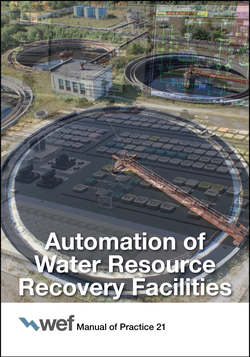Читать книгу Automation of Water Resource Recovery Facilities - Water Environment Federation - Страница 220
4.10.1 Lead–Lag Control
ОглавлениеLead–lag control is used when there are two or more devices performing the same function. By staging these devices, they can be used for a wider range of variation of demand. As the device is first needed, the lead device is started. When the first device is not sufficient to meet demand, the lag device is started. If demand is reduced, the lag device is stopped, leaving only the lead device operating. If demand is reduced with only the lead device operating, that may also be stopped.
Lead–lag control can be used with any number of devices (Figure 7.10). For example, if there are three devices available for operation, one will be the lead device, one will be the first lag, or Lag1, and the last will be the second lag, or Lag2. If both the lead and Lag1 devices are in operation and demand is not met, then the Lag2 device will be started. Likewise, if all three devices are in operation and demand is reduced, the Lag2 device will be stopped first, leaving the lead and Lag1 devices operating. There is no limit to the number of lag devices that can be used in lead–lag control, although two or three devices operated together are the most common.
FIGURE 7.10 Lead-lag control.
Lead–lag control has traditionally been used for constant-speed devices, most notably for constant-speed pumping systems. However, it can be used for variable-speed devices and allows for an extended automatic variation of range beyond that available with one device’s available modulation. For multiple variable-speed devices, the lead device will vary in speed typically using PID. Rules-based control is used to determine when to start and stop lag devices. If the lead devices’ speed control reaches its maximum while demand is increasing, a lag device will start. Typically, all devices in operation are controlled to the same speed (provided the devices are identical) so that the overall control methodology can continue to operate regardless of the number of devices in operation. If multiple devices are in operation and are operating at the minimum speed while demand is decreasing, the lowest lag device will be stopped.
Often, design of the system allows for one of the devices to be out of service. For example, with a three-pump system, only two of the three pumps might be needed for automatic operation and, therefore, one of the three pumps will not operate automatically.
Typically, selecting which device is assigned to the lead or lag level is left to an operator. Sometimes, automatic switching of the lead device is provided to ensure that all devices receive roughly equivalent use; however, in practice, there is often a device that is less efficient or has some mechanical issues that require its use to be minimized. In that instance, allowing an operator to manually assign it a lower lag rating will ensure that its use is minimized.
While an operator may choose which device has a lead or a lag value, there is often still a need for automatic reassigning of lead–lag assignment in the event of a failure or loss of availability of any specific device. For example, if the lead pump fails, automatically moving the Lag1 pump to the lead pump position and the Lag2 pump to the Lag1 position will keep the control system operating correctly in automatic mode until an operator is available.
